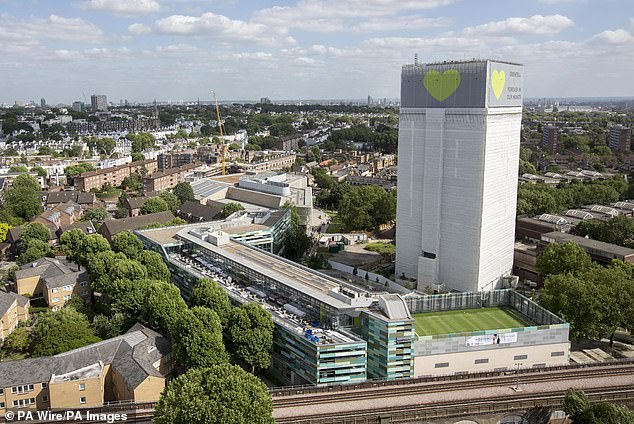Residents living in unsafe high-rise buildings have slammed new measures aimed at protecting them from soaring repair bills.
They claim rules outlined in the draft Building Safety Bill, revealed this week, do nothing to protect them from having to pick up the enormous costs required to make their homes safe.
Some of the properties were built using flammable materials, similar to those that contributed to the Grenfell Tower disaster three years ago.
Other properties have the required building materials missing and consequently do not pass current safety regulations. Some had the flammable materials added after to make the properties more aesthetically pleasing.
Residents face massive repair costs following the Grenfell Tower disaster three years ago
It means homeowners are left in unsafe homes that are almost impossible to sell as lenders refuse to provide funding to potential buyers.
The new legislation would apply to buildings that are at least 18 metres high, with the Government insisting it will give residents new protections.
It said these would include leaseholders being able to challenge inaction on safety issues from building owners, and being protected against huge bills to pay for safety work.
Some residents have been asked to pay thousands of pounds each to cover the cost of replacing unsafe aluminium composite cladding.
The Government is providing funding to help with costs, having launched a £1billion Building Safety Fund to remove unsafe non-ACM cladding from buildings.
It followed some freeholders and developers delaying or refusing to pay to fix the problems despite the Government insisting that they ‘have a legal responsibility to ensure their buildings are safe’.
On publishing the draft Building Safety Bill this week, the Government stated: ‘The draft bill will make sure that those responsible for the safety of residents are accountable for any mistakes and must put them right.
‘It will fully establish the regulator that will enforce new rules and take strong actions against those who break them.’

The Government insists the bill will give residents living in tower blocks new protections
However, residents and campaigners argued that they had been ‘thrown under the bus’ as far as costs were concerned.
In particular, they highlighted a the bill’s new ‘Building Safety Charge’ that leaseholders will need to pay.
The Government said the new charge would ‘make it easy for leaseholders to see and know what they are being charged for when it comes to keeping their building safe’ – and that ‘to make sure that these costs are affordable, we have deliberately included powers to limit the costs that can be re-charged to leaseholders’.
We bought in good faith and later learned out building had dangerous cladding. We are now stuck in an unsafe and worthless flat while we wait for a resolution.
Ross Taylor – tower block resident
But one homeowner living at an affected block in North London – who asked not to be named amid fears of reprisals from the owner of his building – said: ‘The bill essentially throws leaseholders under the bus when it comes to remedial costs, rather than sparing us from the financial burden.’
Another resident – Ross Taylor, living at a separate tower block in the capital – said: ‘This bill is heartbreaking. We have been begging for Government help for so long, but this bill will make things so much worse.
‘It passes the buck for building safety issues from developers, freeholders and the Government to innocent leaseholders. We bought in good faith and later learned our building had dangerous cladding.
‘We are now stuck in an unsafe and worthless flat while we wait for a resolution. By siding with freeholders, the Government has opened the door to delays and huge charges for fixing the problem.’

The Government said the new charge would ‘make it easy for leaseholders to see and know what they are being charged for when it comes to keeping their building safe’
Will Martin, of the UK Cladding Action Group explained that after years of hearing the government say that leaseholders should not have to pay to fix fire safety defects not of their making, this was exactly what is going to happen.
He said: ‘Leaseholders have today woken to the disappointing news that the Government’s draft Building Safety Bill imposes on innocent residents a Building Safety Charge that does exactly that.
‘Instead of committing that leaseholders should not pay any costs for historic repairs to buildings we do not own, for defects we did not create, the draft bill has now firmly placed these costs entirely on the shoulders of leaseholders, further forcing impossible and unachievable payment periods on us and overwriting existing leases in order to do so.’
He called on the Government to work with leaseholder groups to amend the bill and make sure that the financial implications are borne entirely by those responsible – the Government and developers.
‘Any other outcome would be a shocking betrayal of the government’s repeated promises to suffering residents, 37 long months on from the Grenfell tragedy; and would cause unimaginable harm to the mental health, wellbeing and financial stability of hundreds of thousands of innocent people in this country,’ Mr Martin concluded.
On announcing the draft bill, Robert Jenrick, the housing secretary, said: ‘I remain committed to making sure we get this right.
‘It is vital that the sector moves in step with us, to provide confidence and reassurance to residents that their safety is firmly at the heart of everything we do.’
And building safety and fire minister Lord Greenhalgh said: ‘As a government we are determined to learn the lessons from that fateful night at Grenfell Tower and ensure that a tragedy like this does not happen again.
‘These are the biggest changes to building safety legislation for nearly 40 years, and they will raise standards across the industry and ensure building owners have nowhere to hide if they break the rules.’

